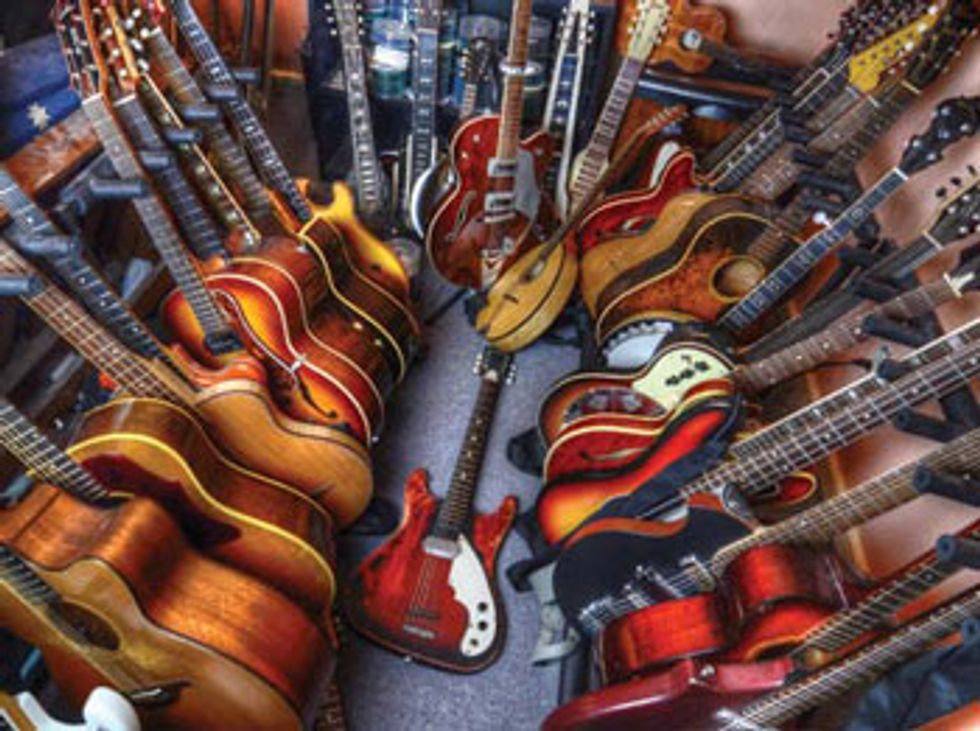Waiting for my flight, I pondered the concept of multiple guitar ownership and how it has passed from the domain of touring or recording musicians into the garages, basements, and bedrooms of so many.

While your guitar closet or band room doesn’t have to be this full, if you’re recording music, you’ll really benefit from having many sonic options at your disposal.
I can’t remember if it was at Dulles or Hartsfield Jackson in Atlanta—but there it was, staring at me from a newsstand rack. Mixed in with the requisite display of coffee mugs and stuffed mascots for the region’s sports teams, was an illustrated guitar shirt in full color. “One Woman, Many Guitars,” it announced proudly. I nodded my head in agreement as I scanned the graphic for my favorite axes. I’d seen it before, but never in this context. Art truly does imitate life. Beyond the idea that electric guitars were so mainstream that they were represented at a major airport other than Nashville’s BNA was the understanding that that this particular thought was so universal. Legions of guitarists will tell you stories of justifying, or even hiding, guitar purchases from their significant other, providing the background for the punch line emblazoned on the shirt.
Waiting for my flight, I pondered the concept of multiple guitar ownership and how it has passed from the domain of touring or recording musicians into the garages, basements, and bedrooms of so many. The rising quality of entry-level guitars has made it possible for the average guitarist to indulge his or her fantasy of collecting a herd of styles and brands of instruments—just like their heroes. Reciprocally, the increased volume of sales has fueled the most recent guitar boom in the instrument’s history.
With many Asian factories each churning out tens of thousands of guitars monthly, microcollections with a variety of famous and not-so-famous brand names have swelled. Accordingly, manufacturers have continued to introduce lower-priced versions of their iconic (or not) models to keep pace with the trend. That practice goes completely contrary to my liking as a builder—and certainly as an observer and amateur historian of revered brands in general. Although one aspect of the owner’s experience is found in a guitar’s acceptable build quality, another is its actual provenance. I want my Harley built in Milwaukee and my Colt made in Connecticut. Your results may vary.
Another growing phenomenon is the upgrading of ultrabudget guitars with aftermarket add-ons in an attempt to create Frankenstein’s monster, where the result equals the sum of the parts. This, of course, tends to ignore the main component, which is the guitar itself. When assembling a cadre of components to replicate an iconic instrument, the obvious lack of the actual icon guarantees failure at one level, despite the sonic payoff. It’s still a kit guitar.
Not every guitarist wants a fake Ferrari in the garage, which brings us to the other reason to collect different types of guitars. Once the emotional hero-worship or status-symbol pieces are in place, the new-breed collector stumbles upon the same thing that pros have learned over time: Every instrument has a personality and a place. The oldest cliché in the book—equating tonalities with colors on a painter’s palette—may not be the most exciting way to look at collecting guitars, but it certainly is practical. It is, very nearly, like the way you’d approach putting together a pedalboard.
In a bigger picture, we all know that Strats and Teles sound different from a Les Paul. They all play differently and that makes you react to them in a different way. When you lay out the foundation of a tune, you can alternate between the articulate twang of single-coils or the full-throttle roar of humbuckers. Sometimes the deep growl of a baritone can inspire an entire composition. But when you need a special, sonic signature to fill in a little gap or make the bridge in a song stand out, that’s when a small collection of different guitars can come in handy. Personally, I enjoy when an artist employs an unusual sound in a song. It makes me remember it and wait for it to come around. A 12-string is good for that and Nashville tuning does it too.
Certain guitars work better with different tunings. Longer scales allow you to lower the pitch without losing clarity. On the other hand, shorter-scale guitars (24.75" or 23") emit some great pinch-harmonics when detuned. I keep a Telecaster around the house that’s pared down to five strings and tuned to open G for rhythm and slide. It’s great for adding a classic-rock sound to a song’s hook or signature riff. You may not be a shredder, but a locking-trem guitar might just be the ticket for memorable single-note lines within the context of a country tune. If you think of your collection as individual solutions that address a wide range of sonic questions, you’ll find that you can never have too many options and almost every guitar has something to offer. The good part is that your Wandre won’t get jealous if you have a little fling with a Gretsch.
The bottom line is that a guitar doesn’t need to have your ultimate dream-tone in order to be collectible or usable. In fact, sometimes the weirder sounding a guitar is, the better. When people ask what my favorite guitar is, I honestly can’t give them an answer. Unlike a good partner, it depends upon the situation.
 Jol Dantzig is a
noted designer, builder,
and player who co-founded
Hamer Guitars,
one of the first boutique
guitar brands, in 1973.
Today, as the director of
Dantzig Guitar Design, he continues to
help define the art of custom guitar. To
learn more, visit guitardesigner.com.
Jol Dantzig is a
noted designer, builder,
and player who co-founded
Hamer Guitars,
one of the first boutique
guitar brands, in 1973.
Today, as the director of
Dantzig Guitar Design, he continues to
help define the art of custom guitar. To
learn more, visit guitardesigner.com.
